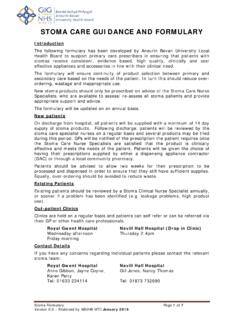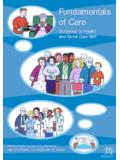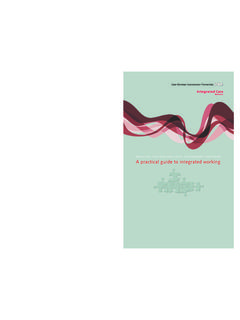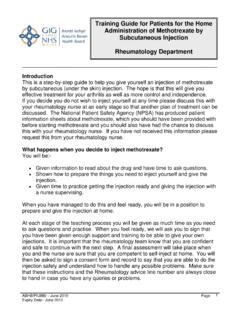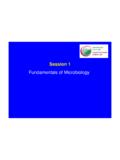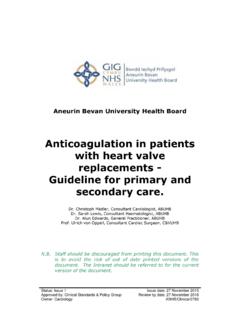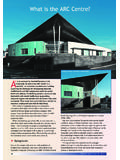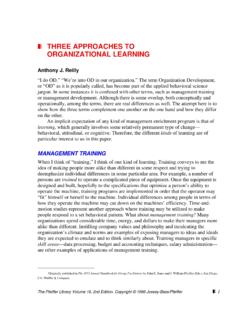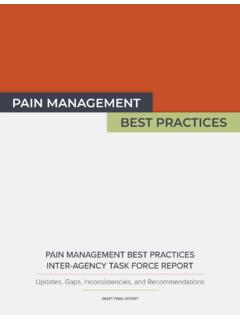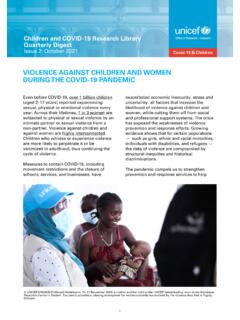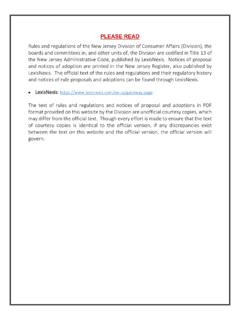Transcription of Advanced Practice The Portfolio - NHS Wales
1 Advanced Practice The PortfolioDave Barton (Chair)Academic Lead for Nursing,Swansea UniversitySandy Harding Senior education and Contracting Manager, Workforce Development, National Leadership and Innovation Agency for HealthcareCharlette Middlemiss Associate Director, Workforce Development, National Leadership and Innovation Agency for HealthcareKim Atkinson Clinical Lead Occupational Therapist, ABM ULHB, Forge Centre, Port TalbotLesley Bevan Assistant Director of Nursing, ABM ULHB, Neath Port Talbot HospitalLinda Theophilus Strategic Lead - Therapies, Cwm Taf LHB, Prince Charles HospitalJulie Hayes Rehab Nurse Practitioner/Medicine and Elderly Care, Princess of Wales HospitalRuth Emanuel Physiotherapy Clinical Manager, ABM ULHB, Singleton HospitalGeorgina Hourahane Lecturer in Adult Nursing, Cardiff University School of Nursing and MidwiferyJayne Lavin Clinical Manager and Lead for education , Training and Staff Development, Aneurin Bevan Health Board, Royal Gwent HospitalHelen Rogers Director, Royal College of Midwives, RCM, Cardiff Martin Semple Associate Director (Professional Practice )
2 , RCN, CardiffWendy Mashlan Senior Nurse Practitioner, Community Integrated Intermediate Care, ABM ULHB Princess of Wales HospitalDenise Richards Nursing Officer, Department for Public Health and Health Professsions, Welsh GovernmentNicola Ryley Assistant Director of Nursing, Aneurin Bevan Health Board, Llanfrechfa Grange HospitalAlison Strode Therapy Advisor for Wales , Welsh GovernmentGlynis Hudson Leadership & Organisation Development Manager, Leadership and Organisation Development Directorate, National Leadership and Innovation Agency for HealthcareAdvanced Practice Framework Task and Finish Group Membership2 Advanced Practice The PortfolioRhian Barnes Lecturer/Professional Head Adult Nursing, Cardiff University School of Nursing and MidwiferyGemma Ellis Consultant Nurse Adult Critical Care Services, Cardiff & Vale UHB, University Hospital of Wales Heath Park, CardiffTim Jones Advanced Paramedic Practitioner, Welsh Ambulance Service NHS Trust, SE Region, Vantage Point House, Cwmbran3 Advanced Practice The PortfolioContentsPurpose 5 Introduction 5 Section One: Personal Details 6 Section Two: Job Description 6 Section Three: Advanced Practice Criteria 7 Section Four: Self Assessment 9 Section Five: Evidence to support the self assessment process 12 Section Six: 360-degree Feedback 13 Section Seven.
3 Reflective Practice 14 References 144 Advanced Practice The PortfolioThese guidelines aim to assist Advanced practitioners engaged in research, education , management, leadership and clinical activity in the development of a Portfolio of evidence that demonstrates Advanced level Practice as outlined in the Framework for Advanced Nursing, Midwifery and Allied Health Professional Practice in Wales (NLIAH 2010).The Portfolio is intended to be used as a resource to support the annual appraisal process. In accordance with local governance arrangements, assessment of clinical Practice will be undertaken by appropriate clinicians and managers and should be recorded in the Portfolio . These individuals will review the Portfolio , including an academic peer reviewer if required. The Professional Lead and Clinical Lead of the service will need to determine who the lead assessor is, in order to co-ordinate and quality assure the assessment activity.
4 Advanced Practice enhances the development of services that better meet the needs of patients and the public in accordance with strategic and regulatory guidance. The Advanced Practice Portfolio supports your development, whatever your field of Practice , both in the post you currently hold and as you progress in your career. As part of the Governance Framework, Health Boards and Trusts are advised to develop and maintain a database of Advanced Practitioners. Once a practitioner is placed on the Advanced Practice Database, portfolios should be reviewed on an annual basis in accordance with the local Health Boards Governance following format is offered as guidance to good Practice for the development of Advanced Practitioner Portfolios. The content should be easy to read and any signposting and cross referencing should be easy for the reader / assessor / reviewer to follow.
5 For example, acronyms are not understood by all people and should be given in full. PurposeIntroduction5 Advanced Practice The PortfolioThis section captures the following types of information: Contact details (name, address, place of work, phone numbers and email address) Qualifications (professional and academic). The practitioner may wish to include relevant and current course documents continuing Professional Development undertaken Curriculum Vitae Narrative context personal context and observation context Current Personal Development Plan and future plans for role / serviceThis section should contain an up to date copy of your Job Description, person specification and Knowledge and Skills Framework outline for your is essential for you to familiarise yourself with both the Job Description and Knowledge and Skills Framework documents of the role as part of your preparation for your annual review these documents should be reviewed in accordance with your local governance arrangements.
6 You may have several reviewers and these could include the identified lead assessor, another professional lead, a clinical lead, and the line manager. In preparation for your Portfolio review you will need to undertake a self assessment of your competency level against the Advanced Practice criteria set out by your local clinical governance leads, and in line with the advance Practice Pillars shown in Table 1. You need to ensure that your Portfolio reflects all the skills and knowledge necessary to fulfil the requirements of the Advanced Practice criteria, Job Description and Knowledge and Skills Framework One: Personal DetailsSection Two: Job Description6 Advanced Practice The PortfolioSection Three: Advanced Practice PillarsThe Framework for Advanced Practice in Wales 2010 sets out the four Pillars of Advanced Practice and articulates the core principle that Advanced Practice is a level of Practice rather than a role.
7 It is not exclusively characterised by the clinical domain but includes those working in research, education or managerial / leadership roles. Evidence of Advanced Practice will be gathered under the following 4 pillars that are shown in Table Management and Leadership Identifying need for change, leading innovation and managing change, including service development Developing case for change Negotiation and influencing skills Networking Team development2. education (either within clinical Practice or education sector) Principles of teaching and learning Supporting others to develop knowledge and skills Promotion of learning/creation of learning environment Service user/carer teaching and information giving Developing service user/carer education materials Teaching, mentorship and coaching3.
8 Research Ability to access research/use information systems Critical appraisal/evaluation skills Involvement in research Involvement in audit and service evaluation Ability to implement research findings into Practice including use of and development of policies/protocols and guidelines. Conference presentations Publications4. Advanced Clinical Practice Decision making/clinical judgement and problem solving Critical thinking and analytical skills incorporating critical reflection Managing complexity Clinical governance Equality & diversity Ethical decision-making Assessment, diagnosis, referral, discharge Developing higher levels of autonomy Assessing and managing risk Non-medical prescribing in line with legislation. Developing confidence Developing therapeutic interventions to improve service user outcomes Higher level communication skills Service user focus/public involvement Promoting and influencing others to incorporate values based care into Practice Development of Advanced psycho-motor skillsTable 1 - Advanced Practice Pillars-Adapted from National Executive Scotland (2011).
9 NOTE: The Toolkit content is subject to periodical Practice The PortfolioNB The prevalence of evidence of Advanced Practice for each pillar will vary in accordance with the particulars of an individual s role. Nevertheless, the Advanced Practitioner should produce some evidence for all four Portfolio should be structured in such a way that there are clearly defined sections that capture the evidence identified within the 4 pillars, and these sections should constitute the main body of the Portfolio . The nature and the quantity of evidence in each section may vary depending on the particular role the practitioner is engaged in. The template is a guideline for the presentation of evidence and should not be seen as a constraint on the creative presentation of evidence of Advanced Practice . Each section should commence with an overall summary and reflection regarding the evidence Practice The PortfolioAdvanced Practice The Portfolio have used an adapted version of Benner s (1984) model of skill acquisition and skill development, that describes five levels or stages of nursing performance: novice, Advanced beginner, competent, proficient and expert.
10 We suggest that you use this model when undertake a self assessment of your Practice against the Advanced Practitioner Pillars. This self assessment will assist your reviewers in evaluating your competence and Four: Self Assessment Figure 1: Adapted from P. Benner (1984) Model of Skills AcquisitionNovice Beginner with no experience Taught general rules to help perform tasks Rules are: context-free, independent of specific cases, and applied universally Rule-governed behaviour is limited and inflexibleAdvanced Beginner Demonstrates acceptable performance Has gained prior experience in actual situations to recognize recurring meaningful components Principles, based on experiences, begin to be formulated to guide actionsCompetent Typically a practitioner with 2-3 years experience on the job in the same area or in similar day-to-day situations More aware of long-term goals Gains perspective from planning own actions based on conscious, abstract.
